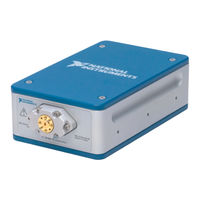National Instruments PXIe-7902 Manuals
Manuals and User Guides for National Instruments PXIe-7902. We have 4 National Instruments PXIe-7902 manuals available for free PDF download: User Manual, Getting Started Manual
National Instruments PXIe-7902 User Manual (98 pages)
High-Speed Serial Instruments
Brand: National Instruments
|
Category: Control Unit
|
Size: 2 MB
Table of Contents
Advertisement
National Instruments PXIe-7902 User Manual (98 pages)
High-Speed Serial Instruments
Brand: National Instruments
|
Category: Network Hardware
|
Size: 3 MB
Table of Contents
National Instruments PXIe-7902 Getting Started Manual (86 pages)
mmWave Transceiver System
Brand: National Instruments
|
Category: Transceiver
|
Size: 5 MB
Table of Contents
Advertisement
National Instruments PXIe-7902 Getting Started Manual (10 pages)
High-Speed Serial Module
Brand: National Instruments
|
Category: Control Unit
|
Size: 0 MB
Table of Contents
Advertisement
Related Products
- National Instruments FlexRIO PXIe-7975R
- National Instruments NI FlexRIO PXIe-7971R
- National Instruments NI PXIe-7961R
- National Instruments NI PXIe-7976R
- National Instruments FlexRIO PXIe-79 R Series
- National Instruments FlexRIO PXIe-7976
- National Instruments NI FlexRIO PXIe-7975
- National Instruments NI PXIe-7972R
- National Instruments NI FlexRIO PXIe-7965R
- National Instruments NI FlexRIO PXIe-7966R


